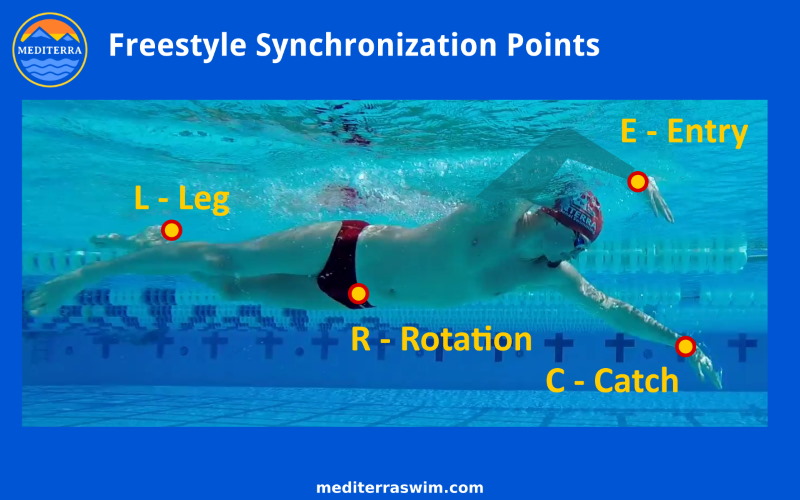How Can We Help?
Lesson for Synchronization
How To Work With Combinations
You start with paying attention to the connection of two synchronization points at a time (like EC, or CR), examining and refining them. After working with related pairs for a while, you may ‘zoom out’ to hold attention on hold three points at a time (like ECR), feeling how they all work together. In the end, you intend to have all four working in smooth synchronicity, but it will be easier to arrive at that when you work on these in pairs, rotating through the combinations.
Eventually, all the individual pieces are brought together here in the full stroke to create a smooth, powerful, synchronized, whole-body propulsive movement.

Description Of Synchronization Combinations
In your session or practice time you should examine each of these combinations several times, making observations about how well the parts feel connected and moving smoothly together.
EC – The Entry and Catch Combination
The moment the entry hand (E) pierces the water is the moment your lead arm (C) sets the catch. If that entry happens a little too late or a little too early, then you are not able to connect the rotation power to the catch.
You may read more detail about the The Entry and Catch Combination.
ER – The Entry and the Rotation
One view…
ER: The entry arm (E) is entering and extending underwater and the body rotation follows after it, as if the torso is pulled by an elastic band.
A second view…
RE: The extending arm (E) underwater feels as if it is being pushed forward by the rotation of the body. It is another way of viewing the same connection as ER.
You may read more detail about The Entry and the Rotation.
CR – The Catch and Rotation
The catch arm slides into catch shape (C) but then hesitates for a microsecond as rotation begins, then the catch arm can gradually increase pressure and shift the loading to the back muscles, lightening the load a bit on the smaller shoulder muscles. Imagine an elastic band tied from the hip to the wrist, and as the hip turns it pulls the wrist of the catch hand with it.
You may read more detail about The Catch and Rotation.
LR – The Leg Press and the Rotation
The press of the leg (L) in a downward arc helps rotate (R) the same side of the torso upward.
You may review the previous lesson on the Leg Press.
LC –The Leg Press and the Catch
Being connected through the torso, the press of the leg also assists with the catch – the press of the leg downward (by helping the torso rotate upward) lightens the loading on the catch arm slightly.
You may read more detail about The Leg Press and the Catch.
LE – The Leg Press and the Entry
Being connected through the torso, the press of the leg (L) on one side of the body helps the entering arm (E) extend fully into Streamline Position on the other side of the body.
You may read more detail about The Leg Press and the Entry.
